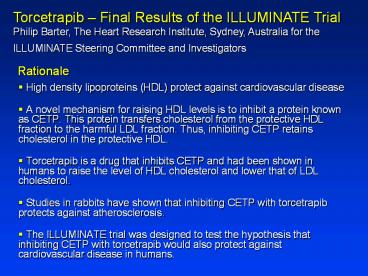High density lipoproteins (HDL) protect against cardiovascular disease - PowerPoint PPT Presentation
1 / 7
Title:
High density lipoproteins (HDL) protect against cardiovascular disease
Description:
Philip Barter, The Heart Research Institute, Sydney, Australia for the ILLUMINATE Steering Committee and Investigators Rationale High density lipoproteins (HDL ... – PowerPoint PPT presentation
Number of Views:89
Avg rating:3.0/5.0
Title: High density lipoproteins (HDL) protect against cardiovascular disease
1
Rationale
Torcetrapib Final Results of the ILLUMINATE
Trial Philip Barter, The Heart Research
Institute, Sydney, Australia for the ILLUMINATE
Steering Committee and Investigators
- High density lipoproteins (HDL) protect against
cardiovascular disease - A novel mechanism for raising HDL levels is to
inhibit a protein known as CETP. This protein
transfers cholesterol from the protective HDL
fraction to the harmful LDL fraction. Thus,
inhibiting CETP retains cholesterol in the
protective HDL. - Torcetrapib is a drug that inhibits CETP and had
been shown in humans to raise the level of HDL
cholesterol and lower that of LDL cholesterol. - Studies in rabbits have shown that inhibiting
CETP with torcetrapib protects against
atherosclerosis. - The ILLUMINATE trial was designed to test the
hypothesis that inhibiting CETP with torcetrapib
would also protect against cardiovascular disease
in humans.
2
ILLUMINATE Long-term Outcomes in Patients With
CHD or CHD Risk Equivalence
Investigation of Lipid Level Management to
Understand its Impact in Atherosclerotic Events
Atorvastatin run-in to LDL lt100 mg/dL (2.6
mmol/L) 4-10 weeks
Torcetrapib titrated atorvastatin dose
Planned 4.5 years of treatment
Titrated atorvastatin dose
Patient Population Subjects Primary End Point
Men or postmenopausal women Statin eligible Any HDL-C level CHD or risk equivalent (type 2 DM) 15,000 7 countries Major cardiovascular events
3
Cardiovascular events and mortality in the
ILLUMINATE trial at termination of the trial on
Dec 02, 2006
- Atorvastatin GroupA (n7534)
- Torcetrapib/Atorvastatin GroupT/A (n7533)
- Compared to A, T/A increased HDL-C by 72 and
reduced LDL-C by 25 - A T/A
- Major cardiovascular events 373 464
(p0.001) - Deaths 59 93 (p0.006)
4
Causes Of Death
Torcetrapib/ Atorvastatin (n93)
Atorvastatin (n59 )
49
35
Any cardiovascular death
26
25
Sudden cardiac death
8
6
Fatal MI - not procedure related
Fatal stroke
0
6
4
1
Other cardiac death
2
1
Fatal heart failure
3
2
Other vascular death/procedure related MI
40
20
Any non-cardiovascular
24
14
Cancer
9
0
Infection
4
2
Other non-cardiovascular
3
4
Trauma/suicide/homicide
4
4
Reason unknown
5
Investigator-reported SAEs of neoplasms
Atorvastatin Group 136 Torcetrapib/atorvastati
n Group 128
Investigator-reported SAEs of infections/infestati
ons
Atorvastatin Group 177 Torcetrapib/atorvastati
n Group 182
6
Off-target pharmacological effects of torcetrapib
unrelated to CETP inhibition
- In patients receiving torcetrapib/atorvastatin
(but not in those receiving atorvastatin alone)
there was a significant - Increase in blood pressure
- Reduction in serum potassium
- Increase in serum bicarbonate
- Increase in serum sodium
- Increase in serum aldosterone
- These changes are consistent with activation of
the renin-angiotensin-aldosterone system - The adverse clinical outcome associated with use
of torcetrapib may have been the consequence of
an off-target pharmacology but the possibility of
an adverse effect of CETP inhibition cannot be
excluded by the results of this randomized trial.
7
Post-hoc Exploratory Analyses in the
Torcetrapib/Atorvastatin Group
Hazard ratios for CHD Death or Non-Fatal MI by
quintile of on-trial HDL-C (referent group is
HDL-C lt 60 mg/dL stratum)
1.00
1.0
0.8
0.67
Plt0.05
0.57
0.6
CHD Death or Non-Fatal MI (Hazard Ratio)
0.47
0.43
0.4
0.2
0
lt60
60-70
71-80
81-93
gt93
Quintiles of HDL-C (mg/dL) at Month 3
Cox proportional hazard model adjusted for age,
gender and baseline HDL-C. Excludes 265 patients
with missing month 3 HDL-C. Preliminary analysis
initiated and authorised by P Barter and
conducted by Pfizer

